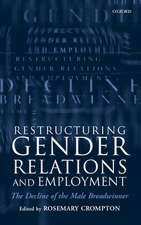Barbara Leigh Smith Bodichon and the Langham Place Group: Women's Source Library
Autor Candida Ann Laceyen Limba Engleză Paperback – 20 oct 2010
| Toate formatele și edițiile | Preț | Express |
|---|---|---|
| Paperback (1) | 368.94 lei 6-8 săpt. | |
| Taylor & Francis – 20 oct 2010 | 368.94 lei 6-8 săpt. | |
| Hardback (1) | 719.65 lei 6-8 săpt. | |
| Taylor & Francis – 25 oct 2001 | 719.65 lei 6-8 săpt. |
Din seria Women's Source Library
-
 Preț: 425.86 lei
Preț: 425.86 lei -
 Preț: 218.85 lei
Preț: 218.85 lei -
 Preț: 447.07 lei
Preț: 447.07 lei -
 Preț: 294.99 lei
Preț: 294.99 lei - 13%
 Preț: 304.48 lei
Preț: 304.48 lei -
 Preț: 291.60 lei
Preț: 291.60 lei -
 Preț: 423.30 lei
Preț: 423.30 lei -
 Preț: 124.31 lei
Preț: 124.31 lei -
 Preț: 323.23 lei
Preț: 323.23 lei
Preț: 368.94 lei
Nou
Puncte Express: 553
Preț estimativ în valută:
70.59€ • 73.71$ • 58.43£
70.59€ • 73.71$ • 58.43£
Carte tipărită la comandă
Livrare economică 05-19 aprilie
Preluare comenzi: 021 569.72.76
Specificații
ISBN-13: 9780415606394
ISBN-10: 041560639X
Pagini: 494
Dimensiuni: 138 x 216 x 25 mm
Greutate: 0.91 kg
Ediția:1
Editura: Taylor & Francis
Colecția Routledge
Seria Women's Source Library
Locul publicării:Oxford, United Kingdom
ISBN-10: 041560639X
Pagini: 494
Dimensiuni: 138 x 216 x 25 mm
Greutate: 0.91 kg
Ediția:1
Editura: Taylor & Francis
Colecția Routledge
Seria Women's Source Library
Locul publicării:Oxford, United Kingdom
Public țintă
Postgraduate and ProfessionalCuprins
Introduction; Part 1 Adelaide Anne Procter (1825–64); Chapter 1 Now; Part 2 Barbara Leigh Smith Bodichon (1827–91); Chapter 2 A Brief Summary, in Plain Language, of the Most Important Laws Concerning Women: Together with a Few Observations Thereon (1854); Chapter 3 Women and Work (1857); Chapter 4 Middle-Class Schools for Girls; Chapter 5 Of Those who are the Property of Others, and of the Great Power that holds Others as Property; Chapter 6 Accomplices; Chapter 7 Reasons for the Enfranchisement of Women; Chapter 8 Objections to the Enfranchisement of Women Considered; Chapter 9 Authorities and Precedents for giving the Suffrage to Qualified Women; Chapter 10 A Conversation on the Enfranchisement of Female Freeholders and Householders; Part 3 Bessie Rayner Parkes (1829–1925); Chapter 11 The Market for Educated Female Labour; Chapter 12 What Can Educated Women Do? (I); Chapter 13 What Can Educated Women Do? (II); Chapter 14 Statistics as to the Employment of the Female Population of Great Britain; Chapter 15 A Year's Experience in Woman's Work; Chapter 16 The Condition of Working Women in England and France; Chapter 17 The Balance of Public Opinion in Regard to Woman's Work; Chapter 18 Female Life in Prison; Chapter 19 A Review of the Last Six Years; Part 4 Jessie Boucherett (1825–1905); Chapter 20 On the Obstacles to the Employment of Women; Chapter 21 On the Education of Girls with Reference to their Future Position; Chapter 22 Local Societies; Chapter 23 On the Choice of a Business; Chapter 24 On the Cause of the Distress prevalent among Single Women; Part 5 Emily Faithfull (1835–95); Chapter 25 Victoria Press; Chapter 26 Women Compositors; Part 6 Isa Craig (1831–1903); Chapter 27 Emigration as a Preventive Agency; Chapter 28 Insanity: its Cause and Cure; Part 7 Maria Susan Rye (1829–1903); Chapter 29 The Rise and Progress of Telegraphs; Chapter 30 On Assisted Emigration; Part 8 Frances Power Cobbe (1822–1904); Chapter 31 The Preventative Branch of the Bristol Female Mission; Chapter 32 What Shall We Do With Our Old Maids?; Chapter 33 Criminals, Idiots, Women and Minors. Is the Classification Sound?; Part 9 Emily Davies (1830–1921); Chapter 34 Female Physicians; Chapter 35 Medicine as a Profession for Women; Chapter 36 The Influence of University Degrees on the Education of Women; Chapter 37 On Secondary Instruction, as Relating to Girls; Part 10 Elizabeth Garrett (1836–1917); Chapter 38 Hospital Nursing; Part 11 Elizabeth Blackwell (1821–1910); Chapter 39 Extracts from the Laws of Life, with special reference to the Physical Education of Girls; Chapter 40 Letter to Young Ladies Desirous of Studying Medicine; Chapter 41 Medicine as a Profession for Women; Index;
Descriere
First published in 1987, this volume reprints material from the 1850's and 1860's, a period which marked a turning point in the history of British feminism.
















